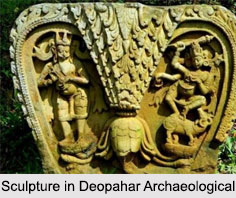 Deopahar, meaning "the hill of the God" is an archaeological site located in Numaligarh, Golaghat District of Assam and spread over 135 hectares of land. This site is consisted of ancient relics, monuments and Shiva temples along with ancient sculptures, coins, temples and bricks of various types. This protected archaeological park and site-museum is under the Directorate of Archaeology, Government of Assam. According to the mythology, this archaeological site was a part of the Kingdom Jarasanda in ancient Assam. Near the site there is situated the Deopahar hill, also known as Deoparvat, which is a part of the Deopani reserve forest. On the top of the hill, there is an ancient stone temple, the construction of which seems to have been incomplete or destroyed by Assam earthquake of 1897. Deopahar Archaeological Site is one of the popular tourist destinations of Assam.
Deopahar, meaning "the hill of the God" is an archaeological site located in Numaligarh, Golaghat District of Assam and spread over 135 hectares of land. This site is consisted of ancient relics, monuments and Shiva temples along with ancient sculptures, coins, temples and bricks of various types. This protected archaeological park and site-museum is under the Directorate of Archaeology, Government of Assam. According to the mythology, this archaeological site was a part of the Kingdom Jarasanda in ancient Assam. Near the site there is situated the Deopahar hill, also known as Deoparvat, which is a part of the Deopani reserve forest. On the top of the hill, there is an ancient stone temple, the construction of which seems to have been incomplete or destroyed by Assam earthquake of 1897. Deopahar Archaeological Site is one of the popular tourist destinations of Assam.
History of Deopahar Archaeological Site
The intricate architectural style of the stone temple of Shiva seems to have been built during 7th and 9th century AD. The temple was erected on a monolithic floor. It has a huge ceiling slab, which is engraved with a large lotus bearing a relief of Vidyadhara holding a scarf and a necklace by both hands. The sculptured stone blocks were curved out of Precambrian rocks. These stone blocks were fixed together with irons hinges on the base of the temple. The entire creative design and style of the temple clearly exhibits the influences of the Gupta period. The door jambs are huge with foliage and drooping petals. They are encircling creepers with animal and sculptural representations of female door keepers with coronets and huge perforated "Patrakundalas". Some other sculptural representations in the temple are Kirtimukha, Kalamakaras, Fangananm Shiva, Sridhar Rudra, Lakshmi- Narayana, Hara Gauris Rashlila, Sarpadevata, Pranayam dhyan, Padma Sakra, Ram and Ravana, Sugriba etc. There are also carvings of figures to depict some scenes from the epics "Mahabharatha", "Ramayana" and "Bhagavata Purana".
Visiting Information to Deopahar Archaeological Site
Deopahar Archaeological Site is about 5 km from Numaligarh Refinery, 61.8 km from Kaziranga National Park, 255 km from Guwahati and approximately 5 km from Brahmaputra River. Numaligarh Railway Station is the nearest to Deopahar. Jorhat Airport is the nearest to connect to Deopahar by flights. National Highway 27 connects Deopahar to other major cities of India by road.



















